#!Women Art Revolution (2010)
Explore tagged Tumblr posts
Text
Pentiment's Complete Bibliography, with links to some hard-to-find items:
I've seen some people post screenshots of the game's bibliography, but I hadn't found a plain text version (which would be much easier to work from), so I put together a complete typed version - citation style irregularities included lol. I checked through the full list and found that only four of the forty sources can't be found easily through a search engine. One has no English translation and I'm not even close to fluent enough in German to be able to actually translate an academic article, so I can't help there. For the other three (a museum exhibit book, a master's thesis, and portions of a primary source that has not been entirely translated into English), I tracked down links to them, which are included with their entries on the list.
If you want to read one of the journal articles but can't access it due to paywalls, try out 12ft.io or the unpaywall browser extension (works on Firefox and most chromium browsers). If there's something you have interest in reading but can't track down, let me know, and I can try to help! I'm pretty good at finding things lmao
Okay, happy reading, love you bye
Beach, Alison I. Women as Scribes: Book Production and Monastic Reform in Twelfth-Century Bavaria. Cambridge Univeristy Press, 2004.
Berger, Jutta Maria. Die Geschichterder Gastfreundschaft im hochmittel alterlichen Monchtum: die Cistercienser. Akademie Verlag GmbH, 1999. [No translation found.]
Blickle, Peter. The Revolution of 1525. Translated by Thomas A. Brady, Jr. and H.C. Erik Midelfort. The Johns Hopkins University Press, 1985.
Brady, Thomas A., Jr. “Imperial Destinies: A New Biography of the Emperor Maximilian I.” The Journal of Modern History, vol 62, no. 2., 1990. pp.298-314.
Brandl, Rainer. “Art or Craft: Art and the Artist in Medieval Nuremberg.” Gothic and Renaissance Art in Nuremberg 1300-1550. The Metropolitan Museum of Art, 1986. [LINK]
Byars, Jana L., “Prostitutes and Prostitution in Late Medieval Bercelona.” Masters Theses. Western Michigan University, 1997. [LINK]
Cashion, Debra Taylor. “The Art of Nikolaus Glockendon: Imitation and Originality in the Art of Renaissance Germany.” Journal of Historians of Netherlandish Art, vol 2, no. 1-2, 2010.
de Hamel, Christopher. A History of Illuminated Manuscripts. Phaidon Press Limited, 1986.
Eco, Umberto. The Name of the Rose. Translated by William Weaver. Mariner Books, 2014.
Eco, Umberto. Baudolino. Translated by William Weaver. Mariner Books, 2003.
Fournier, Jacques. “The Inquisition Records of Jacques Fournier.” Translated by Nancy P. Stork. Jan Jose Univeristy, 2020. [LINK]
Geary, Patrick. “Humiliation of Saints.” In Saints and their cults: studies in religious sociology, folklore, and history. Edited by Stephen Wilson. Cambridge University Press, 1985. pp. 123-140
Harrington, Joel F. The Faithrul Executioner: Life and Death, Honor and Shame in the Turbulent Sixteenth Century. Farrar, Straus and Giroux, 2013.
Hertzka, Gottfired and Wighard Strehlow. Grosse Hildegard-Apotheke. Christiana-Verlag, 2017.
Hildegard von Bingen. Physica. Edited by Reiner Hildebrandt and Thomas Gloning. De Gruyter, 2010.
Julian of Norwich. Revelations of Divine Love. Translated by Barry Windeatt. Oxford Univeristy Press, 2015.
Karras, Ruth Mazo. Sexuality in Medieval Europe: Doing Unto Others. Routledge, 2017.
Kerr, Julie. Monastic Hospitality: The Benedictines in England, c.1070-c.1250. Boudell Press, 2007.
Kieckhefer, Richard. Forbidden rites: a necromancer’s manual of the fifteenth century. Sutton, 1997.
Kuemin, Beat and B. Ann Tlusty, The World of the Tavern: Public Houses in Early Modern Europe. Routledge, 2017.
Ilner, Thomas, et al. The Economy of Duerrnberg-Bei-Hallein: An Iron Age Salt-mining Center in the Austrian Alps. The Antiquaries Journal, vol 83, 2003. pp. 123-194
Lang, Benedek. Unlocked Books: Manuscripts of Learned Magic in the Medieval Libraries of Central Europe. The Pennsylvania State University Press, 2008
Lindeman, Mary. Medicine and Society in Early Modern Europe. Cambridge University Press, 2019.
Lowe, Kate. “’Representing’ Africa: Ambassadors and Princes from Christian Africa to Renaissance Italy and Portugal, 1402-1608.” Transactions of the Royal Historical Society Sixth Series, vol 17, 2007. pp. 101-128
Meyers, David. “Ritual, Confession, and Religion in Sixteenth-Century Germany.” Archiv fuer Reformationsgenshichte, vol. 89, 1998. pp. 125-143.
Murat, Zuleika. “Wall paintings through the ages: the medieval period (Italy, twelfth to fifteenth century).” Archaeological and Anthropological Sciences, vol 23, no. 191. Springer, October 2021. pp. 1-27.
Overty, Joanne Filippone. “The Cost of Doing Scribal Business: Prices of Manuscript Books in England, 1300-1483.” Book History 11, 2008. pp. 1-32.
Page, Sophie. Magic in the Cloister: Pious Motives, Illicit Interests, and Occullt Approaches to the Medieval Universe. The Pennsylvania State University Press, 2013.
Park, Katharine. “The Criminal and the Saintly Body: Autopsy and Dissectionin Renaissance Italy.” Renaissance Quarterly, vol 47, no. 1, Spring 1994. pp. 1-33.
Rebel, Hermann. Peasant Classes: The Bureaucratization of Property and Family Relations under Early Habsburg Absolutism, 1511-1636. Princeton University Press, 1983.
Rublack, Ulinka. “Pregnancy, Childbirth, and the Female Body in Early Modern Germany.” Past & Present,vol. 150, no. 1, February 1996.
Salvador, Matteo. “The Ethiopian Age of Exploration: Prester John’s Discovery of Europe, 1306-1458.” Journal of World History, vol. 21, no. 4, 2011. pp.593-627.
Sangster, Alan. “The Earliest Known Treatise on Double Entry Bookkeeping by Marino de Raphaeli.” The Accounting Historians Journal, vol. 42, no. 2, 2015. pp. 1-33.
Throop, Priscilla. Hildegarde von Bingen’s Physica: The Complete English Translation of Her Classic Work on Health and Healing. Healing Arts Press, 1998.
Usher, Abbott Payson. “The Origins of Banking: The Brimitive Bank of Deposit, 1200-1600.” The Economic History Review, vol. 4, no. 4. 1934. pp.399-428.
Waldman, Louis A. “Commissioning Art in Florence for Matthias Corvinus: The Painter and Agent Alexander Formoser and his Sons, Jacopo and Raffaello del Tedesco.” Italy and Hungary: Humanism and Art in the Early Renaissance. Edited by Peter Farbaky and Louis A. Waldman, Villa I Tatti, 2011. pp.427-501.
Wendt, Ulrich. Kultur and Jagd: ein Birschgang durch die Geschichte. G. Reimer, 1907.
Whelan, Mark. “Taxes, Wagenburgs and a Nightingale: The Imperial Abbey of Ellwangen and the Hussite Wars, 1427-1435.” The Journal of Ecclesiastical History, vol. 72, no. 4, 2021, pp.751-777.
Wiesner-Hanks, Merry E. Women and Gender in Early Modern Europe. Cambridge University Press, 2008.
Yardeni, Ada. The Book of Hebrew Script: History, Palaeography, Script Styles, Calligraphy & Design. Tyndale House Publishers, 2010.
568 notes
·
View notes
Text
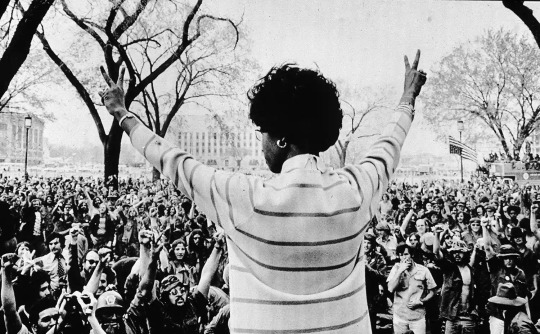
Black women have made important contributions to the United States throughout its history. However, they are not always recognized for their efforts, with some remaining anonymous and others becoming famous for their achievements. In the face of gender and racial bias, Black women have broken barriers, challenged the status quo, and fought for equal rights for all. The accomplishments of Black female historical figures in politics, science, the arts, and more continue to impact society.
Marian Anderson (Feb. 27, 1897–April 8, 1993)

Underwood Archives / Getty Images
Contralto Marian Anderson is considered one of the most important singers of the 20th century. Known for her impressive three-octave vocal range, she performed widely in the U.S. and Europe, beginning in the 1920s. She was invited to perform at the White House for President Franklin Roosevelt and First Lady Eleanor Roosevelt in 1936, the first African American so honored. Three years later, after the Daughters of the American Revolution refused to allow Anderson to sing at a Washington, D.C. gathering, the Roosevelts invited her to perform on the steps of the Lincon Memorial.
Anderson continued to sing professionally until the 1960s when she became involved in politics and civil rights issues. Among her many honors, Anderson received the Presidential Medal of Freedom in 1963 and a Grammy Lifetime Achievement Award in 1991.
Mary McLeod Bethune (July 10, 1875–May 18, 1955)
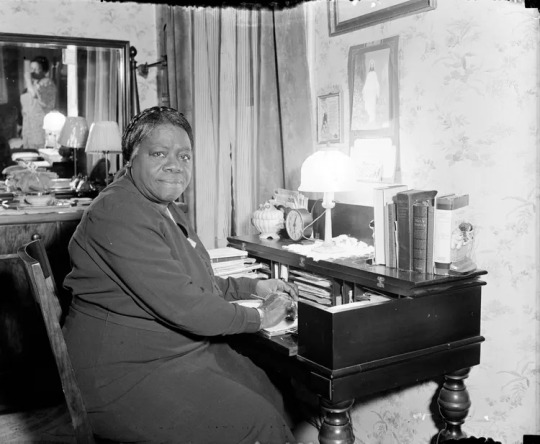
PhotoQuest / Getty Images
Mary McLeod Bethune was an African American educator and civil rights leader best known for her work co-founding the Bethune-Cookman University in Florida. Born into a sharecropping family in South Carolina, the young Bethune had a zest for learning from her earliest days. After stints teaching in Georgia, she and her husband moved to Florida and eventually settled in Jacksonville. There, she founded the Daytona Normal and Industrial Institute in 1904 to provide education for Black girls. It merged with the Cookman Institute for Men in 1923, and Bethune served as president for the next two decades.
A passionate philanthropist, Bethune also led civil rights organizations and advised Presidents Calvin Coolidge, Herbert Hoover, and Franklin Roosevelt on African American issues. In addition, President Harry Truman invited her to attend the founding convention of the United Nations; she was the only African American delegate to attend.
Shirley Chisholm (Nov. 30, 1924–Jan. 1, 2005)
Don Hogan Charles / Getty Images
Shirley Chisholm is best known for her 1972 bid to win the Democratic presidential nomination; she was the first Black woman to make this attempt in a major political party. However, she had been active in state and national politics for more than a decade and had represented parts of Brooklyn in the New York State Assembly from 1965 to 1968. She became the first Black woman to serve in Congress in 1968. During her tenure, she co-founded the Congressional Black Caucus. Chisholm left Washington in 1983 and devoted the rest of her life to civil rights and women's issues.
Althea Gibson (Aug. 25, 1927–Sept. 28, 2003)
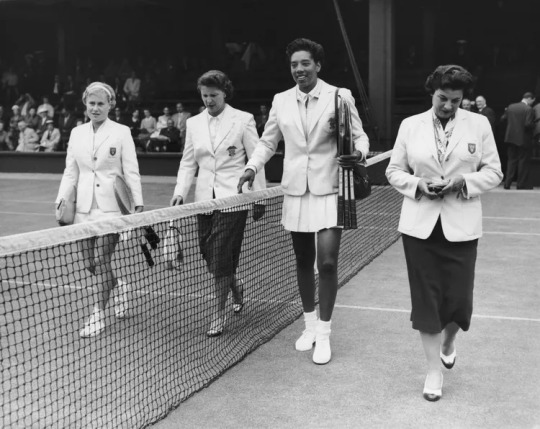
Reg Speller / Getty Images
Althea Gibson started playing tennis as a child in New York City, winning her first tennis tournament at age 15. She dominated the American Tennis Association circuit, reserved for Black players, for more than a decade. In 1950, Gibson broke the tennis color barrier at Forest Hills Country Club (site of the U.S. Open); the following year, she became the first African American to play at Wimbledon in Great Britain. Gibson continued to excel at the sport, winning both amateur and professional titles through the early 1960s.
Dorothy Height (March 24, 1912–April 20, 2010)
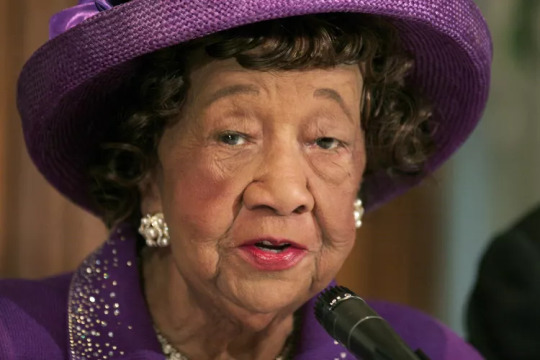
Chip Somodevilla / Getty Images
Dorothy Height has been described as the godmother of the women's movement because of her work for gender equality. For four decades, she led the National Council of Negro Women (NCNW )and was a leading figure in the 1963 March on Washington. Height began her career as an educator in New York City, where her work caught the attention of Eleanor Roosevelt. Beginning in 1957, she led the NCNW and also advised the Young Women's Christian Association (YWCA). She received the Presidential Medal of Freedom in 1994.
Rosa Parks (Feb. 4, 1913–Oct. 24, 2005)
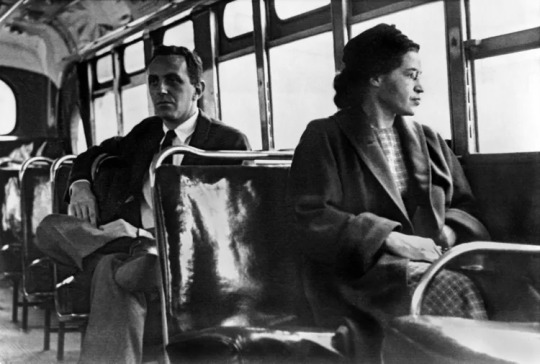
Underwood Archives / Getty Images
Rosa Parks became active in the Alabama civil rights movement after marrying activist Raymond Parks in 1932. She joined the Montgomery, Alabama, chapter of the National Association for the Advancement of Colored People (NAACP) in 1943 and was involved in much of the planning that went into the famous bus boycott that began the following decade. Parks is best known for her December 1, 1955, arrest for refusing to give up her bus seat to a White rider. That incident sparked the 381-day Montgomery Bus Boycott, which eventually desegregated that city's public transit. Parks and her family moved to Detroit in 1957, and she remained active in civil rights until her death.
Augusta Savage (Feb. 29, 1892–March 26, 1962)
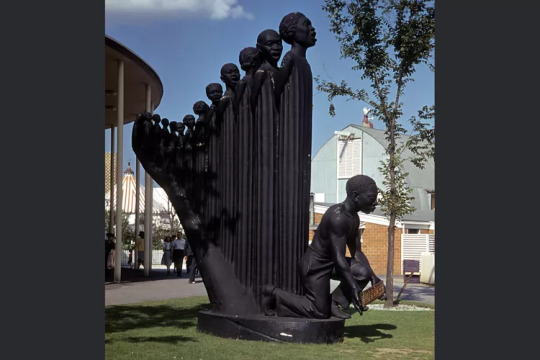
Archive Photos / Sherman Oaks Antique Mall / Getty Images
Augusta Savage displayed an artistic aptitude from her youngest days. Encouraged to develop her talent, she enrolled in New York City's Cooper Union to study art. She earned her first commission, a sculpture of civil rights leader W.E.B. Du Bois, from the New York library system in 1921, and several other commissions followed. Despite meager resources, she continued working through the Great Depression, making sculptures of several notable Black people, including Frederick Douglass and W. C. Handy. Her best-known work, "The Harp," was featured at the 1939 World's Fair in New York, but it was destroyed after the fair ended.
Harriet Tubman (1822–March 20, 1913)

Library of Congress
Enslaved from birth in Maryland, Harriet Tubman escaped to freedom in 1849. The year after she arrived in Philadelphia, Tubman returned to Maryland to free her family members. Over the next 12 years, she returned nearly 20 times, helping more than 300 enslaved Black people escape bondage by ushering them along the Underground Railroad. The "railroad" was the nickname for a secret route that enslaved Black people used to flee the South for anti-slavery states in the North and to Canada. During the Civil War, Tubman worked as a nurse, a scout, and a spy for Union forces. After the war, she worked to establish schools for formerly enslaved people in South Carolina. In her later years, Tubman also became involved in women's rights causes.
Phillis Wheatley (May 8, 1753–Dec. 5, 1784)

Culture Club/Hulton Archive/Getty Images
Born in Africa, Phillis Wheatley came to the U.S. at age 8, when she was captured and sold into enslavement. John Wheatley, the Boston man who enslaved her, was impressed by Phillis' intellect and interest in learning, and he and his wife taught her to read and write. The Wheatleys allowed Phillis time to pursue her studies, which led her to develop an interest in poetry writing. A poem she published in 1767 earned her much acclaim. Six years later, her first volume of poems was published in London, and she became known in both the U.S. and the United Kingdom. The Revolutionary War disrupted Wheatley's writing, however, and she was not widely published after it ended.
Charlotte Ray (Jan. 13, 1850–Jan. 4, 1911)
Charlotte Ray has the distinction of being the first African American woman lawyer in the United States and the first woman admitted to the bar in the District of Columbia. Her father, active in New York City's Black community, made sure his young daughter was well educated; she received her law degree from Howard University in 1872 and was admitted to the Washington, D.C., bar shortly afterward. Both her race and gender proved to be obstacles in her professional career, and she eventually became a teacher in New York City instead.
#10 of the Most Important Black Women in U.S. History#Black Women#Black Women Matter#Black Lives Matter#us history
220 notes
·
View notes
Text
Media analysis and misconceptions
Oasis Nadrama, 30/06/2024

[ Illustration: Both Sides of the Soul, by Wojtek Siumak ]
AUTEUR THEORY An angle of analysis postulating the director as the main and most significant creative force behind the movie. By extension, auteur theory is interesting in the declarations, actions, positions and previous trajectory of this one artist, as well as the possibility (explicit or not) that they may have a larger aesthetic project a single movie is only a part of. Example: Film director John Carpenter is generally understood to be the main force behind the 1982 movie The Thing. He wanted to direct a remake to the eponymous 1951 story since a long time. He reworked the screenplay, chose the actors, worked closely with them as well as the creature designers and special effect specialists, and focused on the editing stage as well. Furthermore, John indicated the movie was part of his "Apocalypse trilogy", a thematic triptych continued with Prince of Darkness (1987) and concluded with In the Mouth of Madness (1994). What Auteur Theory is not: Auteur theory never says that the director is the sole entity behind a movie, nor does it oppose entirely different approaches. It also does not mean the word of the main creator should always be trusted and constitutes the alpha and omega of intradiegetic truth and extradiegetics themes. On the contrary, auteur theory encourages you to think of artists as human being, who can lie, who can fail, who can forget things, etc.
DEATH OF THE AUTHOR An angle of analysis warning against considering the author and their decisions as the main and only key to understanding the work (see auteur theory above). The term was coined in an essay by literary theorist Roland Barthes, who proposed we should instead consider the perspective of every reader as paramount and fruitful by itself. Example: Mary Shelley wrote Frankenstein as a horror story and it expresses humanist themes, mostly exploring traditional philosophical and spiritual matters, in gothic and christian tradition. However, it is now considered as one of the first works of modern science fiction and countless analyses have been done with other perspectives. One could envision the creature as an incarnation of miscarriage, a subconscious expression of budding proletarian revolution, a symbol of freedom, of art itself. Any interpretation is possible, and all are valuable. The fact a lot of analyses may develop themes the author knew nothing of, or did not wish to talk about, is not important: what's important is the construction of new points of view and cross-section concepts which can then enrich the larger cultural conversation. What Death of the Author is not: The idea the creator should be entirely dismissed as a factor. In fact, a lot of Death of the Author analyses do include a model of the artist's intent, or at least trajectory and experiences. Some hybrid approaches advise to consider the author as first and foremost a vastly unwilling and inconscious relay of larger cultural developments.
MALE GAZE The specific ways in which cultural objects in current Western cultures (paintings, statues, books, comic books, video games, movies, plays, music etc) present the feminine body in a process of hypersexualization and fetishization. In movie theory we are mostly talking about the composition of the picture (the way rule of thirds is used to targed chests and butts), in video games the focus is more on character design, etc, etc, but it's all about the way women are understood as objects of desire first and foremost (or exclusively). Example: In the 2010 video game NieR, Kainé walking around in fetishistic underwear and the camera longing on her butts and boobs is textbook male gaze. As are the assertions that there's "a reason" behind the hypersexualization (there's ALWAYS "a reason", there's also "a reason" for Quiet's outfits and dancing scenes in MGS5, etc). What the male gaze is not: It describes the approach in the cultural product itself, not the behavior of people towards the cultural product… and even less the behavior of people in daily life! People are ALLOWED to be horny at women's butts. Looking at someone's ass when invited, or noticing it in mundane situations (as long as the person is not focusing on it), is NOT male gaze.
8 notes
·
View notes
Text
Happy Birthday 🎂 🥳 🎉 🎈 🎁 🎊 to The Most Magical & Sexiest Italian👩🏻🇮🇹❤ Goddess To Ever Grace This Earth 🌎
She is a Amazing Actress & a Incredible Model for Eternal Beauty. Hey that's Italian for ya 😉
Born 30 September 1964
She is an Italian actress and model who began her career as a fashion model before working in Italian, American and French films.
She has an eclectic filmography in a range of genres and languages, and her accolades include the David di Donatello, Globo d'oro and Nastro d'Argento awards. In 2018, Forbes Italy included her in their list of the 100 most successful Italian women.
Bellucci was represented by Elite Model Management and modelled for Dolce & Gabbana campaigns. She made her acting debut in the Italian television miniseries Vita coi figli (1991); she went on to play one of Dracula's brides in the horror film Bram Stoker's Dracula (1992) and then enrolled in acting classes. After appearing in Italian productions, she had her breakthrough role in The Apartment (1996), for which she received a César Award nomination for Most Promising Actress. Bellucci came to the attention of American audiences in Under Suspicion (2000) and gained greater international recognition as Malèna Scordia in Malèna (2000). Bellucci starred in the period horror Brotherhood of the Wolf (2001) and the comedy Asterix & Obelix: Mission Cleopatra (2002). She portrayed a rape victim in the controversial thriller Irréversible (2002), and Persephone in the 2003 science-fiction films The Matrix Reloaded and The Matrix Revolutions.
Bellucci was praised for her portrayal of Mary Magdalene in the drama The Passion of the Christ (2004). She played a prostitute in How Much Do You Love Me? (2005) and Shoot 'Em Up (2007), and acted in diverse roles in other films, including The Whistleblower (2010), The Ages of Love (2011), and The Wonders (2014). Her role in Ville-Marie (2015) earned her the Dublin Film Critics' Circle Award for Best Actress. At the age of 50, Bellucci appeared in the James Bond film Spectre (2015), becoming the oldest Bond girl in the history of the franchise. She later appeared in films such as On the Milky Road (2016) and The Man Who Sold His Skin (2020). Bellucci's television appearances include the series Mozart in the Jungle (2016) and the original French version of Call My Agent! (2018). Bellucci made her stage debut in 2019 as Maria Callas in Letters and Memoirs. She also played Delores in Beetlejuice Beetlejuice (2024).
Bellucci starred alongside her second husband Vincent Cassel in on-screen partnerships that spanned ten years. She has remained involved in modelling, and worked as a brand ambassador for luxury brands such as Cartier and Dior. Some media outlets have labelled Bellucci a sex symbol. Bellucci received the knight insignias of the Order of Arts and Letters in 2006 and of the Legion of Honour in 2016. She represents Italy as a permanent member of the Academy of Motion Picture Arts and Sciences.
PLEASE WISH THIS LEGENDARY & ICONIC ITALIAN👩🏻🇮🇹❤ ACTRESS, MODEL, SEX SYMBOL & GODDESS , A VERY HAPPY BIRTHDAY 🎂 🥳 🎉 🎈 🎁 🎊
YOU ALL KNOW SHOULD HER, & IF YOU DONT. YOU BETTER
YOU HAVE SEEN HER MOVIES 🎥 IN BOTH ITALIAN & ENGLISH & MORE.
& SHE IS & ALWAYS WILL BE THE SEXIEST ITALIAN MODEL ON THE FACE OF THIS EARTH 🌎 & A MAJOR CRUSH FOR ME GROWING UP 🥰😍
GIVE IT UP FOR
THE 1 & ONLY
MS. MONICA ANNA MARIA BELLUCI 👩🏻🇮🇹❤
HAPPY 60TH BIRTHDAY 🎂 🥳 🎉 🎈 🎁 🎊 TO YOU MS . BELLUCI 👩🏻🇮🇹❤ & HERE'S TO MANY MORE YEARS TO COME










#MonicaBelluci #ItalianGoddess
3 notes
·
View notes
Note
Why do you think Logan was hard on women, as Shiv said? I'm sure a big part of it is good ol' fashioned misogyny combined with him being generally awful to everybody, but do you think it also has to do with losing Helen and Rose so young?
Oh, gosh, this feels like a question I could probably write a million word answer to, but ultimately, yeah, I do think he’s a misogynist and I do think losing his mother and sister at such a crucial age impacted his relationship to women as a whole.
I also don’t think we can't discount the era he was born into as being crucial in shaping his views on women overall.
I think – prior to the current era of politics with the reversal of things like affirmative action and Roe v Wade – it was pretty normal to view progress as a straight line going up. While that’s shifted recently, I think there is still this tendency to view the past as slowly progressing instead of the absolute swings and roundabouts that it was and is, and I think that idea particularly permeates when it comes to women’s rights. Which makes sense, right? In America, women got the right to vote in 1920, Amelia Earhart became the first woman pilot in 1932, women seriously entered the workforce en masse during WWII between 1941 and 1945, Rosa Parks didn’t give up her seat in 1955, the birth control pill was approved in 1960, JFK signed into law the equal pay act in 1963.
That seems, on paper, like a line going up, but that’s not what reality was.
The reality was that after all those things, women faced extreme backlash, and on top of that, there were these dramatic shifts with established gender roles that shook things up! This was reflected, like most things are, in art.
A million years ago in my film theory class at university, I actually wrote an essay about this and noir cinema, which as an entire genre is about male impotence post-WWII and female empowerment and this new sense of the unknowability of women which men felt extremely personally in this era. This is, of course, embodied by the iconic femme fatale character trope which dominated cinema in the late ‘40s through ‘50s, and is understood to be a figure born of male anxiety post-WWII (and man, if she isn’t great), but that anxiety came from the lack of social services to help very damaged men navigate their return to cities that had drastically changed since they’d left them.
That era was also dominated by the creation of suburbia, which was built as a social reward for these traumatised men and a trap for newly liberated women. It was about trying to remind men of what they’d seen their friends die for, while telling women where they belonged.
Logan came of age in the midst of that social identity crisis (he would’ve turned 18 in 1956! At the late peek of noir cinema!), a crisis that would only be compound with the Vietnam War that his brother would enlist in, and the sexual revolution. Logan’s life was peppered with male failure and violence, and the mystery and the loss of women, in his father’s death and his uncle’s abuse, even in his brother never making it to the front lines in Vietnam; in his mother’s abandonment, his sister’s death and his aunt’s implied absence.
He collects tokens of masculinity in medals of wars he never fought, and he romanticises the unknowability of women like Marcia and Rhea and Shiv, because it’s what he was taught. It’s the era he grew up in, and Logan, as we saw time and time again, is a character who never quite learns.
So why is he so hard on women? I mean, he is, but I also think he romanticises them to an extent that robs them of their personhood, which feeds back into the era he came of age in. Women then were capable, but unknowable, which made them threatening and emasculating, which is exactly how Logan treats all the women he encounters. They’re femme fatales to him until he can unpick their stitches and figure them out and re-cast them as supporting characters to his own story. He’s a 1950s guy, living in the 2010s, and unfortunately, I don’t think that’s all that rare in real life even now.
#logan roy#succession meta#hbo succession#i do think he was deeply traumatised by the forced separation from his mother and sister and the death of his sister though#funnily enough though i do tend to still think that manifests most with kendall though#just because he's the only child who ever truly tries to leave him in s3#which we see of course in 3.08#welcome to my ama
32 notes
·
View notes
Text

In honor of Women’s History Month
Women Artists in Revolution (WAR) created this poster to protest the Whitney Museum of American Art’s 1969 Annual (later became Biennial), which included only eight women artists out of the 143 artists shown.
WAR was a New York City-based collective of American women artists and activists formed in 1969. It was formed out of the “inhospitable atmosphere of the Art Workers’ Coalition (AWC),” which had a number of separate affinity groups including the Guerrilla Art Action Group, but was male-dominated and often sidelined women members and their causes.
In 1970, WAR members sent letters to the Whitney Museum and the Museum of Modern Art, demanding that both museums change their policies to be more inclusive of women artists.
It was not until the 2010 Whitney Biennial that more than half of the artists shown were women. For the upcoming 2024 Biennial, fewer than a quarter of the artists use he/him pronouns.
Women artists together : art in the age of women's liberation Tobin, Amy, 1989- [author] New Haven ; London : Yale University Press, 2023. English HOLLIS number: 99157153582903941
#WomenArtistsInRevolution#WomensHistoryMonth#WomenArtists#Activism#HarvardFineArtsLibrary#Fineartslibrary#Harvard#HarvardLibrary
6 notes
·
View notes
Text
Having the opportunity to explore this year’s Met Costume Exhibit ‘Women Dressing Women’ gave me the chance to learn just how big of a role that women had in helping shape the fashion industry into what it is today. Presented in what I would call a four act play, act I titled ‘Anonymity’ begins with the entrance of women in the fashion world. Dressmaking was first seen as an extension of domestic work in the 16th century done by women, but as the growing vocation made its way to the United States women would begin embroidering their work as to have it be rightfully credited to them, but also helping fashion historians keep track of who designed what.
Act II is what I could only cheekily refer to as “old maiden clothes.” Or the birthplace of female autonomy in creating pieces such as lingerie and evening gowns. As I was walking through this part of the exhibit I couldn’t help but chuckle at the idea of some of these pieces being considered lingerie. For example, when staring at Marie Gerber’s ‘Evening Ensemble’ I kept thinking how conservative it is when I compare it to big lingerie brands such as Victoria’s Secret and Savage Fenty. Having grown up on those brands it’s not that strange to see why I would think Gerber was being a bit too modest with her design. Another of my favorite look from this act included Jeanne Lanvin’s ‘Cyclone’ evening gown who would create her own boutique with no financial backing.
Act III titled ‘Agency’ and could be compared to the third wave of feminism, saw a more revealing woman break into the scene. With the rise of the British Punk scene and popular rock bands like The Rolling Stones, Sex Pistols and Black Sabbath, it inspired British designers like Betsey Johnson and Vivienne Westwood to help create a new, edgy look that could match this subversive culture. Fashion was no longer just for the elite, it became an important symbol in cultural revolution and rebellion. Something that women designers could understand and relate to as they continued to push into the mainstream and make their collections not just works of art but a loud disruption to a corrupt and stiff society. Some of my favorite looks from this act include Betsey Johnson’s ‘Paraphernalia’ that I consider paying homage to the rise of hippie culture and the Beatles smash hit ‘Yellow Submarine.’ It was made most famous by model Baby Jane Holzer. Vivienne Westwood’s ‘On Liberty’ recognizes the British High Class and fun fact Vivienne Westwood’s second husband Malcolm McLaren was the manager of the Sex Pistols and Vivienne would often times design their wardrobes growing popularity for both her and the band. I would also be remiss if I didn’t mention the work of Ann Lowe, an African American designer who would go on to make, and then remake the day before due to a flood in her basement, Jackie Kennedy’s wedding dress which she would receive no credit for.
Act IV titled ‘Absence/Omission’ would introduce the “modern woman” created to feature and examine the inclusion of women with different body types as well as showcasing designs made for women who live with disabilities such as Aaron Philips who would have a mannequin modeled after her wearing peices designed by Collina Strada. Aaron Philips is most notable for her debut in the Moschino Fall ‘22 show. This act will also feature pieces from Danish designer Jasmin Søe who creates ensembles for those who live with achondroplasia(little person syndrome) as well as Ester Manas who is known for championing plus size women with her creations.
Though my favorite pieces would in this exhibit would come from Marie Grazia Chiuri ensemble for Dior. Marie captures everything I love about Dior, the combining of high luxury activities with haute couture to match in this fencing inspired ensemble. Tory Burch’s 2024 resort white dress is simplistic in nature but reminds me of something out of the classical Swan Lake ballet show(or if you’re a bit edgy the 2010 cult film ‘Black Swan’). Along with Simone Rocha’s couture dress that I can absolutely give no notes on, these would be my favorite pieces that I found myself coming back to often. Donna Karen’s ‘93 evening dress is honorably mentioned too due to Hillary Clinton wearing it (very distastefully in my opinion) at the 1993 State Dinner. However the gown itself was beautiful and reminded me of a longer version of Maddie Perez’s New Years dress in season 2 of ‘Euphoria.’
Overall these collection was both inspiring to see. I have only had the opportunity to visit the Met costume exhibit twice. The previous time focusing on works of Karl Lagerfeld. This exhibit however taught me more about women’s role in fashion and their struggle to breakthrough than any fashion course I could potentially take. The importance of preserving this history is obvious. Without the knowledge of Ann Lowe, Jackie Kennedy’s famous wedding dress would have continued to go uncredited and a Black woman would have been forgotten to history. These are the types of exhibits that matter. In preserving and showcasing our history, we are able to teach and inspire a new generation of fashion critics, designers and models to see what is possible in this amazing industry and if you find yourself in New York I would highly recommend making time to check out the exhibit.
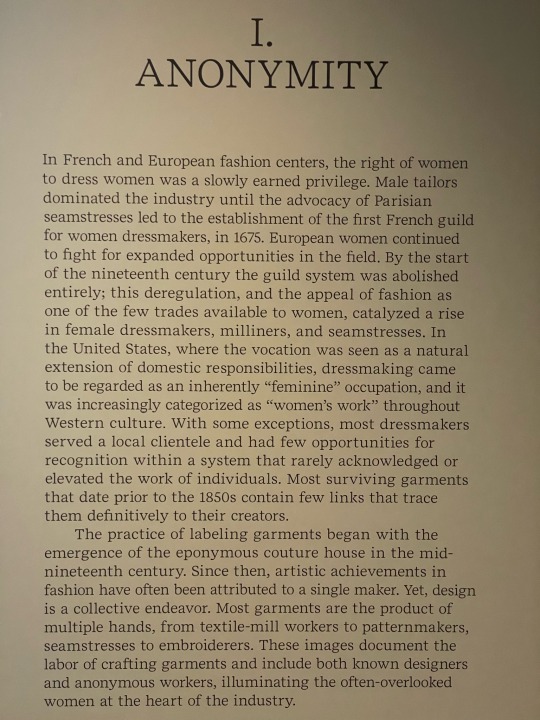
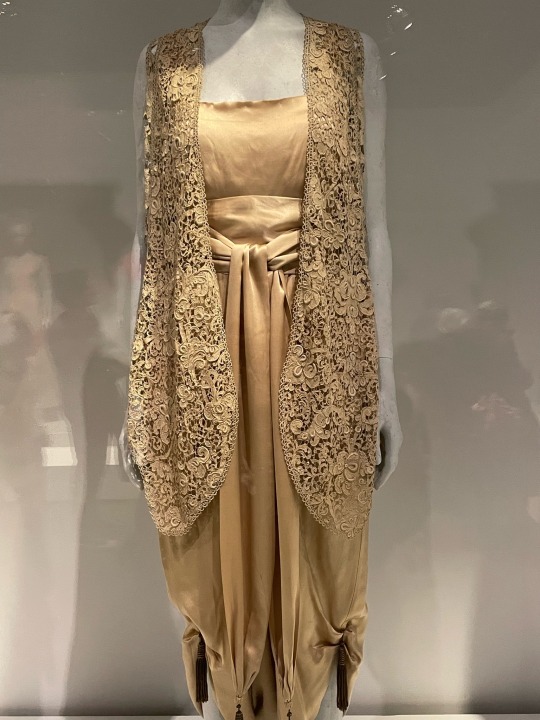
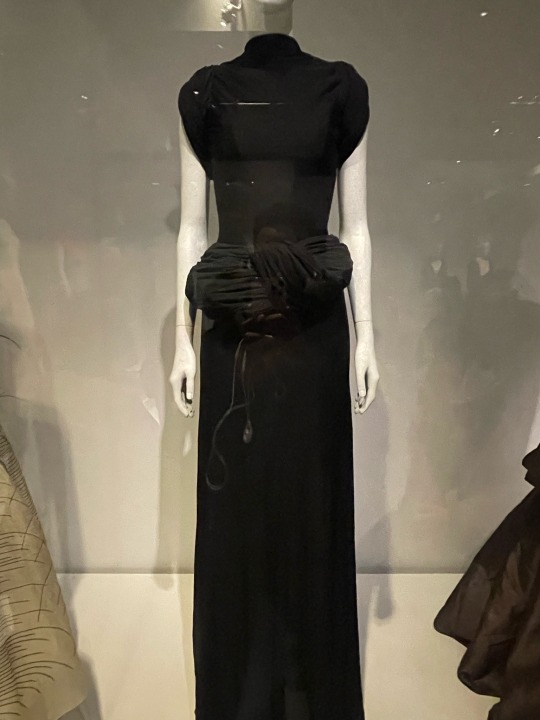
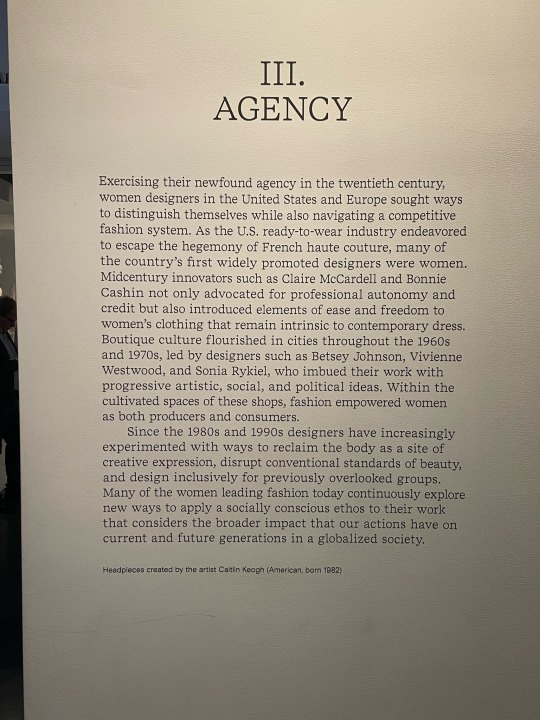
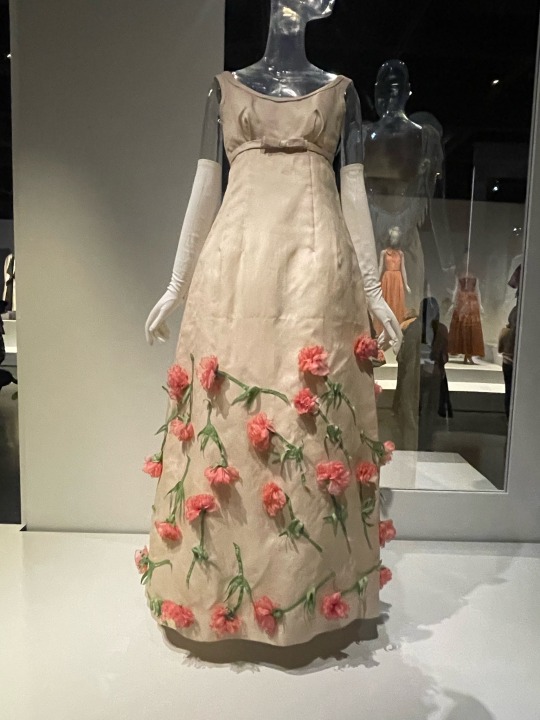
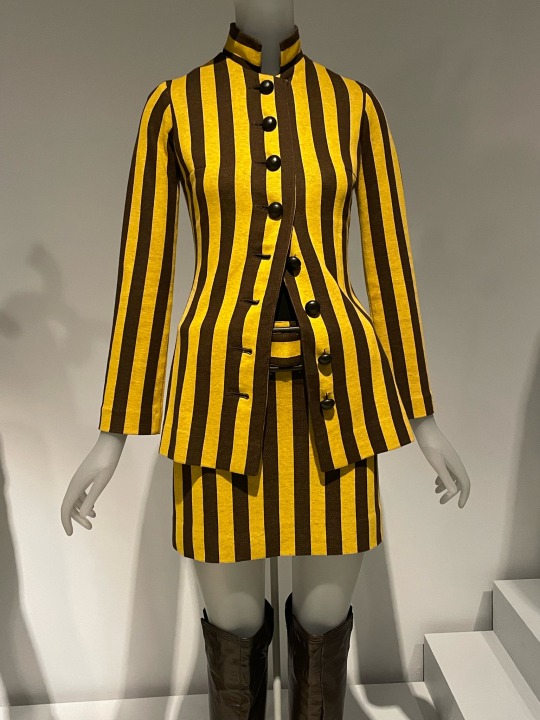
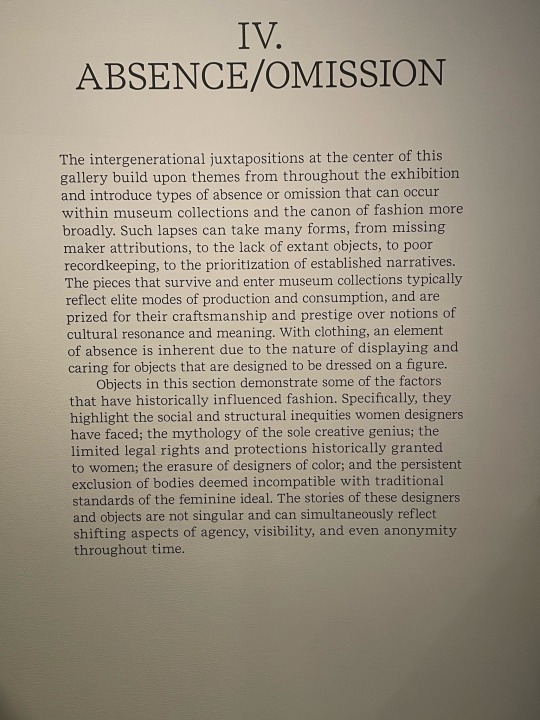
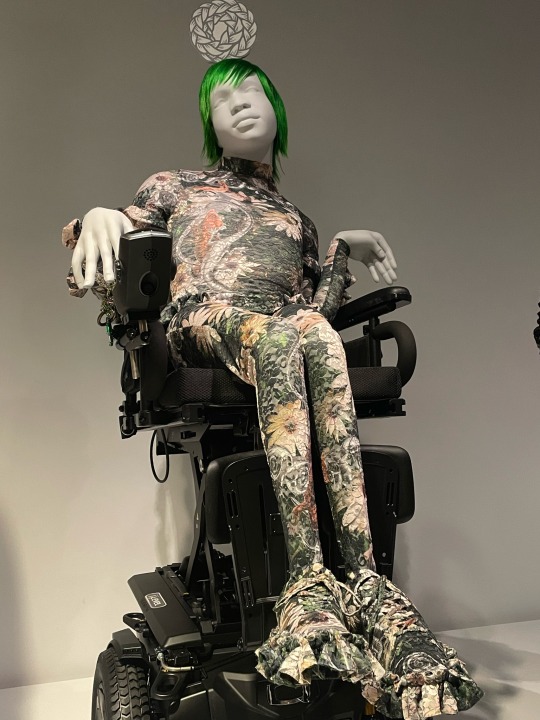
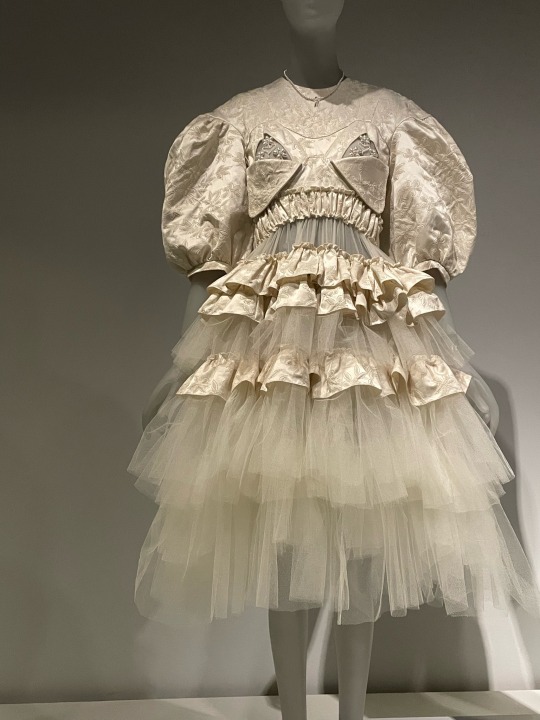
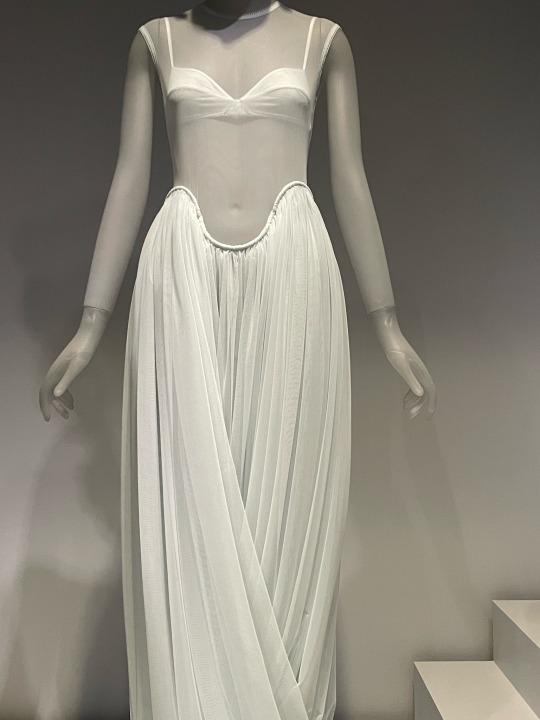
#dior#fashion#new york#vivienne westwood#betsey johnson#tory burch#simone rocha#met museum#fashion history#black history
3 notes
·
View notes
Text
A Historical Perspective on Sexy Sleepwear Trends
Sexy sleepwear has evolved significantly over the years, reflecting changes in societal norms, fashion trends, and cultural attitudes toward intimacy and femininity. Here's a historical perspective on how sexy sleepwear has transformed from functional garments to symbols of empowerment and self-expression:
Victorian Era (1837–1901): Modesty Meets Elegance Style: Sleepwear in the Victorian era was largely functional and modest. Women typically wore long, loose-fitting nightgowns made of cotton or linen. Details: High necklines, long sleeves, and lace or embroidery embellishments were common, offering a touch of elegance while maintaining modesty. Cultural Influence: This era emphasized propriety and modesty. Sleepwear was designed to prioritize coverage, even in private settings.
1920s–1930s: The Rise of Glamorous Nightwear Style: The Roaring Twenties brought about a shift toward more luxurious fabrics like silk and satin. Bias-cut nightgowns and chemises with delicate straps became popular. Details: Lace trims, sheer fabrics, and flowing silhouettes added a touch of sensuality, inspired by the Art Deco movement. Cultural Influence: Women began to embrace more freedom in fashion and self-expression during this time, reflecting broader social changes like the women’s suffrage movement.
1940s–1950s: Pin-Up Style and Hourglass Glamour Style: The post-war period saw the emergence of form-fitting sleepwear that highlighted the hourglass figure. Babydolls, slips, and peignoir sets became staples. Details: Fabrics like nylon and chiffon became more common. Lace and ruffles were added to create a flirtatious look, often inspired by pin-up culture. Cultural Influence: Hollywood and pin-up models like Marilyn Monroe popularized sexy sleepwear as a symbol of glamour and femininity. Women aspired to bring this elegance into their own lives.
1960s–1970s: Bold Colors and Playful Designs Style: The sexual revolution and counterculture movements of the 1960s and 1970s influenced a more daring approach to sleepwear. Mini babydolls, teddies, and sheer gowns became trendy. Details: Bright colors, psychedelic prints, and playful embellishments like feathers and bows were introduced. Cultural Influence: This era celebrated sexual liberation, and sleepwear reflected the changing attitudes toward intimacy and freedom.
1980s: Power Dressing Meets Lingerie Style: The 1980s saw a mix of opulence and boldness in sleepwear. Structured corsets, lace bodysuits, and matching lingerie sets gained popularity. Details: High-cut legs, bold colors like red and black, and intricate lace dominated the era’s sexy sleepwear trends. Cultural Influence: The rise of supermodels and brands like Victoria’s Secret brought lingerie and sexy sleepwear into mainstream fashion, making it a coveted part of women’s wardrobes.
1990s: Minimalism and the Slip Dress Revolution Style: The minimalist trends of the 1990s extended to sleepwear, with slip dresses becoming a fashion statement both in and out of the bedroom. Details: Satin and silk dominated, with simple spaghetti straps and clean lines. Neutral tones and pastels were popular choices. Cultural Influence: Grunge and minimalist aesthetics influenced the era’s fashion. Celebrities like Kate Moss brought the slip dress to prominence, making it both chic and sultry.
2000s: Lingerie as Outerwear Style: The 2000s blurred the line between sleepwear and daywear. Camisoles, bralettes, and satin shorts were often styled as outerwear. Details: Playful prints, pastel tones, and delicate lace trims reflected a youthful, romantic aesthetic. Cultural Influence: The rise of celebrity culture and brands like Victoria’s Secret reinforced the idea that lingerie and sleepwear were key elements of a woman’s identity and confidence.
2010s: Body Positivity and Inclusivity Style: The 2010s marked a shift toward inclusive and diverse designs in sexy sleepwear. Bodysuits, bralettes, and robes catered to a wider range of body types. Details: Stretchable fabrics, adjustable straps, and bold patterns became prominent, emphasizing comfort and self-expression. Cultural Influence: The body positivity movement inspired brands to celebrate diverse body shapes and sizes, redefining sexy sleepwear as empowering rather than conforming.
2020s: Sustainability and Personal Empowerment Style: Modern sexy sleepwear combines eco-friendly materials with versatile designs. Bodysuits, slip dresses, and lingerie-inspired pajamas offer both comfort and style. Details: Neutral tones, intricate lace, and soft, breathable fabrics dominate. Many pieces are designed for both lounging and layering. Cultural Influence: The emphasis on sustainability and self-care has influenced a shift toward sleepwear that prioritizes personal empowerment and ethical fashion choices.
Final Thoughts Sexy sleepwear trends have transitioned from modest, functional designs to symbols of self-expression, empowerment, and individuality. Each era reflects broader societal changes, with sleepwear evolving to meet the needs and desires of the time. Today, sexy sleepwear celebrates diversity, comfort, and confidence, proving that beauty transcends time and trends.
0 notes
Text
Holidays 1.18
Holidays
Anniversary of the Founding of Lima (Peru)
Bobby Vinton Day (Chicago, Illinois)
The Day the Disco Died
Dia de la Divina Pastora Bank Holiday (Venezuela)
Field Hockey Day
Flag Day (Honduras)
Four an' Twenty Day (Scotland)
Hair Dryer Appreciation Day
Heroes’ Day (Congo)
International AHC Day
Internet Freedom Day
International Laughter Day (Portugal)
Jazz Day
Lay Awake and Whisper in the Dark Day
Maintenance Day
Mercury Day (French Republic)
Metric System Day
National Forest Day
National Michigan Day
National Sanctity of Human Life Day
Royal Thai Armed Forces Day (Thailand)
Sandwich Islands Day
Stalking Awareness Day of Action
Thaipoosam (a.k.a. Thaipusam or Thaipoosam Cavadee; India, Malaysia, Mauritius)
Thesaurus Day
UFO Day
Waking Day (Elder Scrolls)
Winnie the Pooh Day
World Day of the Snowman
World Religion Day
Food & Drink Celebrations
National Gourmet Coffee Day
National Peking Duck Day
Unsliced Bread Day
Nature Celebrations
Indian Mallow (Conjecture; Korean Flower Days)
Independence, Flag & Related Days
Lima (Founded; Aniversario de Lima; Peru; 1535)
New Scireland (Declared; 2010) [unrecognized]
Revolution Day (Tunisia)
Sandwich Islands (a.k.a. Hawai’i; Discovered by Capt. Cook; 1778)
3rd Saturday in January
Bald Eagle Appreciation Days begin [3rd Saturday]
Baltic Porter Day (Poland) [3rd Saturday]
Learn to Ski Day [3rd Saturday]
National No Phones at Home Day (UK) [3rd Saturday]
National Tulip Day (Netherlands) [3rd Saturday]
National Use Your Gift Card Day [3rd Saturday]
Polar Bear Jump & Ugly Fish Toss (Seward, Alaska) [begins 3rd Saturday]
Sandwich Saturday [Every Saturday]
Sight-Saving Sabbath Weekend [begins 3rd Saturday]
Six For Saturday [Every Saturday]
Soup Swap Day [3rd Saturday]
Spaghetti Saturday [Every Saturday]
Weekly Holidays beginning January 18 (2nd Full Week of January)
Bald Eagle Appreciation Days [thru 1.19]
Geneva Restaurant Week (Geneva, Illinois) [thru 1.26]
International Week of Prayer for Christian Unity [thru 1.25]
Restaurant Weeks (San Antonio Area, Texas) [thru 2.1]
Festivals Beginning January 18, 2025
Apalachicola Oyster Cook-Off (Apalachicola, Florida)
Beaufort Oyster Festival (Beaufort, South Carolina) [thru 1.19]
Comic Con India (Bangalore, India) [thru 1.19]
Lemon Ball (Springfield, Pennsylvania)
Winter Wineland (Sonoma County, California) [thru 1.19]
Feast Days
A.A. Milne (Humanism)
Amy Carmichael (Church of England)
Athanasius of Alexandria (Eastern Orthodox Church)
Beatrix d’Este (Roman Catholic; Blessed)
Bruma IV (Pagan)
Chair of St. Peter (Roman Catholic)
Confession of Peter (Eastern Orthodox, some Anglican and Lutheran Churches)
Cyril of Alexandria (Christian; Saint)
Day of Danu (Celtic Goddess of the Earth, Moon, Fertility, Wisdom, Wealth, Abundance, Wind and Water)
Deicolus (Christian; Saint)
Egg Juggling Day (Pastafarian)
Feast of Neith (Goddess of War & Hunting; Ancient Egypt)
Feast of the Cross (Eastern Orthodox Church)
Feast of the Kitchen-God Zao Jun (China; Everyday Wicca)
Feast of Women as Cultivators (Persian)
Festival of Neith (Ancient Egypt; Goddess of the Hunt and Warfare; Starza Pagan Book of Days)
Jacob Bronowski (Humanism)
Juggling Day (Pastafarian)
Leobadus (Roman Catholic; Saint)
The Luideag (Washer at the Ford; Celtic Book of Days)
Margaret of Hungary (Christian; Saint)
Martin Luther (Church of the SubGenius; Saint)
Peter-Paul and Marilou (Muppetism)
Prisca (Christian; Saint)
Robert Anton Wilson (Humanism)
Theocrats of Tibet (Positivist; Saint)
36 Companions in Egypt (Christian; Sains)
Ulfrid (Christian; Saint)
Volusianus of Tours (Christian; Saint)
Secular Saints Days
Muhammed Ali (Sports)
John Boorman (Entertainment)
Raymond Briggs (art)
Jacob Bronowski (Science)
Carroll Cloar (Art)
Kevin Costner (Entertainment)
Rubén Darío (Literature)
Cary Grant (Entertainment)
Oliver Hardy (Entertainment)
Elmore James (Music)
Eddie Jones (Art)
Danny Kaye (Entertainment)
A.A. Milne (Literature)
Antoine Pevsner (Art)
Mark Rylance (Entertainment)
Jason Segel (Entertainment)
Kiki Smith (Art)
Daniel Webster (Law, Politics)
Robert Anton Wilson (Literature)
Lucky & Unlucky Days
Shakku (赤口 Japan) [Bad luck all day, except at noon.]
Premieres
Bend It Like Beckham (Film; 2002)
Bentley Motors (Automobile Company; 1919)
Blood Simple (Film; 1984)
The Bomb in the Cellar or Bullwinkle Lowers the Boom (Rocky & Bullwinkle Cartoon, S6, Ep. 338; 1965)
Bungle Uncle (Loopy De Loop Cartoon; 1962)
The Cherry Orchard (Play; 1904)
Cloverfield (Film; 2008)
Doctor Bluebird (Color Rhapsody Cartoon; 1936)
Dumb Patrol (WB LT Cartoon; 1964)
A Fistful of Dollars (Film; 1967)
Fresh Air (NPR Radio Series; 1975)
Gigantosaurus (Animated TV Series; 2019)
The Gloom Chasers (Scrappy Cartoon; 1935)
Grandma’s Pet (Oswald the Luck Rabbit Cartoon; 1932)
Hard to Be a God, by Arkady Strugatsky (Novel; 1964)
How I Met Your Father (TV Series; 2022)
Jeepers Creepers, recorded by Louis Armstrong (Song; 1939)
The Jeffersons (TV Series; 1975)
Legends of the Superheroes: Part 1 (Hanna-Barbera Animated TV Movie; 1979)
Lovin’ You, by Minnie Ripperton (Song; 1975)
The L Word (TV Series; 2004)
Mary and the Witch’s Flower (Animated Film; 2018)
The Nose, by Dmitri Shostakovich (Opera; 1928)
Once Around (Film; 1991)
Pumping Iron (Documentary Film; 1977)
27 Dresses (Film; 2008)
Six Millions Dollar Man (TV Series; 1974)
Socko in Morocco (Woody Woodpecker Cartoon; 1954)
Star vs. the Forces of Evil (Animated TV Series; 2015)
Svengali’s Cat (Might Mouse Terrytoons Cartoon; 1946)
Tom and Jerry: Blast Off to Mars (Animated Film; 2005)
Tortilla Flaps (WB LT Cartoon; 1958)
United States of Tara (TV Series; 2009)
Up the River or Yangtze with the Laughing Face (Rocky & Bullwinkle Cartoon, S6, Ep. 337; 1965)
The Vacuum Gun, Parts 1 & 2 (Underdog Cartoon, S3, Eps. 33 & 34; 1967)
Today’s Name Days
Margitta, Ulfried, Uwe (Austria)
Atanas, Atanaska (Bulgaria)
Biserka, Margareta, Priska (Croatia)
Vladislav (Czech Republic)
Prisca (Denmark)
Lauli, Laura (Estonia)
Laura (Finland)
Gwendal, Prisca (France)
Margitta, Prisca, Ulfried, Uwe (Germany)
Athanasios, Kyrillos, Thanasis (Greece)
Piroska (Hungary)
Beatrice, Leonardo, Liberata, Prisca, Priscilla (Italy)
Akselis, Antis, Antons (Latvia)
Gedgaudas, Jogailė, Jolita, Liberta (Lithuania)
Hild, Hildur (Norway)
Bogumił, Jaropełk, Krystyna, Liberata, Małgorzata, Piotr, Pryska (Poland)
Atanasie, Chiril (Romania)
Bohdana (Slovakia)
Faustina, Margarita, Prisca, Priscila (Spain)
Hilda, Hildur (Sweden)
Cyril (Ukraine)
Faustina, Faustine, Fraser, Frazer (USA)
Today is Also…
Day of Year: Day 18 of 2025; 347 days remaining in the year
ISO: Day 6 of Week 3 of 2025
Celtic Tree Calendar: Ruis (Elder) [Day 28 of 28]
Chinese: Month 12 (Ding-Chou), Day 19 (Ding-Hai)
Chinese Year of the: Dragon 4722 (until January 29, 2025) [Wu-Chen]
Coptic: 10 Tubah 1741
Hebrew: 18 Teveth 5785
Islamic: 18 Rajab 1446
J Cal: 18 White; Foursday [18 of 30]
Julian: 5 January 2025
Moon: 77%: Waning Gibbous
Positivist: 18 Moses (1st Month) [Theocrats of Tibet]
Runic Half Month:Peorth (Womb, Dice Cup) [Day 12 of 15]
Season: Winter (Day 29 of 90)
Week: 2nd Full Week of January
Zodiac: Capricorn (Day 28 of 30)
0 notes
Text
Holidays 1.18
Holidays
Anniversary of the Founding of Lima (Peru)
Bobby Vinton Day (Chicago, Illinois)
The Day the Disco Died
Dia de la Divina Pastora Bank Holiday (Venezuela)
Field Hockey Day
Flag Day (Honduras)
Four an' Twenty Day (Scotland)
Hair Dryer Appreciation Day
Heroes’ Day (Congo)
International AHC Day
Internet Freedom Day
International Laughter Day (Portugal)
Jazz Day
Lay Awake and Whisper in the Dark Day
Maintenance Day
Mercury Day (French Republic)
Metric System Day
National Forest Day
National Michigan Day
National Sanctity of Human Life Day
Royal Thai Armed Forces Day (Thailand)
Sandwich Islands Day
Stalking Awareness Day of Action
Thaipoosam (a.k.a. Thaipusam or Thaipoosam Cavadee; India, Malaysia, Mauritius)
Thesaurus Day
UFO Day
Waking Day (Elder Scrolls)
Winnie the Pooh Day
World Day of the Snowman
World Religion Day
Food & Drink Celebrations
National Gourmet Coffee Day
National Peking Duck Day
Unsliced Bread Day
Nature Celebrations
Indian Mallow (Conjecture; Korean Flower Days)
Independence, Flag & Related Days
Lima (Founded; Aniversario de Lima; Peru; 1535)
New Scireland (Declared; 2010) [unrecognized]
Revolution Day (Tunisia)
Sandwich Islands (a.k.a. Hawai’i; Discovered by Capt. Cook; 1778)
3rd Saturday in January
Bald Eagle Appreciation Days begin [3rd Saturday]
Baltic Porter Day (Poland) [3rd Saturday]
Learn to Ski Day [3rd Saturday]
National No Phones at Home Day (UK) [3rd Saturday]
National Tulip Day (Netherlands) [3rd Saturday]
National Use Your Gift Card Day [3rd Saturday]
Polar Bear Jump & Ugly Fish Toss (Seward, Alaska) [begins 3rd Saturday]
Sandwich Saturday [Every Saturday]
Sight-Saving Sabbath Weekend [begins 3rd Saturday]
Six For Saturday [Every Saturday]
Soup Swap Day [3rd Saturday]
Spaghetti Saturday [Every Saturday]
Weekly Holidays beginning January 18 (2nd Full Week of January)
Bald Eagle Appreciation Days [thru 1.19]
Geneva Restaurant Week (Geneva, Illinois) [thru 1.26]
International Week of Prayer for Christian Unity [thru 1.25]
Restaurant Weeks (San Antonio Area, Texas) [thru 2.1]
Festivals Beginning January 18, 2025
Apalachicola Oyster Cook-Off (Apalachicola, Florida)
Beaufort Oyster Festival (Beaufort, South Carolina) [thru 1.19]
Comic Con India (Bangalore, India) [thru 1.19]
Lemon Ball (Springfield, Pennsylvania)
Winter Wineland (Sonoma County, California) [thru 1.19]
Feast Days
A.A. Milne (Humanism)
Amy Carmichael (Church of England)
Athanasius of Alexandria (Eastern Orthodox Church)
Beatrix d’Este (Roman Catholic; Blessed)
Bruma IV (Pagan)
Chair of St. Peter (Roman Catholic)
Confession of Peter (Eastern Orthodox, some Anglican and Lutheran Churches)
Cyril of Alexandria (Christian; Saint)
Day of Danu (Celtic Goddess of the Earth, Moon, Fertility, Wisdom, Wealth, Abundance, Wind and Water)
Deicolus (Christian; Saint)
Egg Juggling Day (Pastafarian)
Feast of Neith (Goddess of War & Hunting; Ancient Egypt)
Feast of the Cross (Eastern Orthodox Church)
Feast of the Kitchen-God Zao Jun (China; Everyday Wicca)
Feast of Women as Cultivators (Persian)
Festival of Neith (Ancient Egypt; Goddess of the Hunt and Warfare; Starza Pagan Book of Days)
Jacob Bronowski (Humanism)
Juggling Day (Pastafarian)
Leobadus (Roman Catholic; Saint)
The Luideag (Washer at the Ford; Celtic Book of Days)
Margaret of Hungary (Christian; Saint)
Martin Luther (Church of the SubGenius; Saint)
Peter-Paul and Marilou (Muppetism)
Prisca (Christian; Saint)
Robert Anton Wilson (Humanism)
Theocrats of Tibet (Positivist; Saint)
36 Companions in Egypt (Christian; Sains)
Ulfrid (Christian; Saint)
Volusianus of Tours (Christian; Saint)
Secular Saints Days
Muhammed Ali (Sports)
John Boorman (Entertainment)
Raymond Briggs (art)
Jacob Bronowski (Science)
Carroll Cloar (Art)
Kevin Costner (Entertainment)
Rubén Darío (Literature)
Cary Grant (Entertainment)
Oliver Hardy (Entertainment)
Elmore James (Music)
Eddie Jones (Art)
Danny Kaye (Entertainment)
A.A. Milne (Literature)
Antoine Pevsner (Art)
Mark Rylance (Entertainment)
Jason Segel (Entertainment)
Kiki Smith (Art)
Daniel Webster (Law, Politics)
Robert Anton Wilson (Literature)
Lucky & Unlucky Days
Shakku (赤口 Japan) [Bad luck all day, except at noon.]
Premieres
Bend It Like Beckham (Film; 2002)
Bentley Motors (Automobile Company; 1919)
Blood Simple (Film; 1984)
The Bomb in the Cellar or Bullwinkle Lowers the Boom (Rocky & Bullwinkle Cartoon, S6, Ep. 338; 1965)
Bungle Uncle (Loopy De Loop Cartoon; 1962)
The Cherry Orchard (Play; 1904)
Cloverfield (Film; 2008)
Doctor Bluebird (Color Rhapsody Cartoon; 1936)
Dumb Patrol (WB LT Cartoon; 1964)
A Fistful of Dollars (Film; 1967)
Fresh Air (NPR Radio Series; 1975)
Gigantosaurus (Animated TV Series; 2019)
The Gloom Chasers (Scrappy Cartoon; 1935)
Grandma’s Pet (Oswald the Luck Rabbit Cartoon; 1932)
Hard to Be a God, by Arkady Strugatsky (Novel; 1964)
How I Met Your Father (TV Series; 2022)
Jeepers Creepers, recorded by Louis Armstrong (Song; 1939)
The Jeffersons (TV Series; 1975)
Legends of the Superheroes: Part 1 (Hanna-Barbera Animated TV Movie; 1979)
Lovin’ You, by Minnie Ripperton (Song; 1975)
The L Word (TV Series; 2004)
Mary and the Witch’s Flower (Animated Film; 2018)
The Nose, by Dmitri Shostakovich (Opera; 1928)
Once Around (Film; 1991)
Pumping Iron (Documentary Film; 1977)
27 Dresses (Film; 2008)
Six Millions Dollar Man (TV Series; 1974)
Socko in Morocco (Woody Woodpecker Cartoon; 1954)
Star vs. the Forces of Evil (Animated TV Series; 2015)
Svengali’s Cat (Might Mouse Terrytoons Cartoon; 1946)
Tom and Jerry: Blast Off to Mars (Animated Film; 2005)
Tortilla Flaps (WB LT Cartoon; 1958)
United States of Tara (TV Series; 2009)
Up the River or Yangtze with the Laughing Face (Rocky & Bullwinkle Cartoon, S6, Ep. 337; 1965)
The Vacuum Gun, Parts 1 & 2 (Underdog Cartoon, S3, Eps. 33 & 34; 1967)
Today’s Name Days
Margitta, Ulfried, Uwe (Austria)
Atanas, Atanaska (Bulgaria)
Biserka, Margareta, Priska (Croatia)
Vladislav (Czech Republic)
Prisca (Denmark)
Lauli, Laura (Estonia)
Laura (Finland)
Gwendal, Prisca (France)
Margitta, Prisca, Ulfried, Uwe (Germany)
Athanasios, Kyrillos, Thanasis (Greece)
Piroska (Hungary)
Beatrice, Leonardo, Liberata, Prisca, Priscilla (Italy)
Akselis, Antis, Antons (Latvia)
Gedgaudas, Jogailė, Jolita, Liberta (Lithuania)
Hild, Hildur (Norway)
Bogumił, Jaropełk, Krystyna, Liberata, Małgorzata, Piotr, Pryska (Poland)
Atanasie, Chiril (Romania)
Bohdana (Slovakia)
Faustina, Margarita, Prisca, Priscila (Spain)
Hilda, Hildur (Sweden)
Cyril (Ukraine)
Faustina, Faustine, Fraser, Frazer (USA)
Today is Also…
Day of Year: Day 18 of 2025; 347 days remaining in the year
ISO: Day 6 of Week 3 of 2025
Celtic Tree Calendar: Ruis (Elder) [Day 28 of 28]
Chinese: Month 12 (Ding-Chou), Day 19 (Ding-Hai)
Chinese Year of the: Dragon 4722 (until January 29, 2025) [Wu-Chen]
Coptic: 10 Tubah 1741
Hebrew: 18 Teveth 5785
Islamic: 18 Rajab 1446
J Cal: 18 White; Foursday [18 of 30]
Julian: 5 January 2025
Moon: 77%: Waning Gibbous
Positivist: 18 Moses (1st Month) [Theocrats of Tibet]
Runic Half Month:Peorth (Womb, Dice Cup) [Day 12 of 15]
Season: Winter (Day 29 of 90)
Week: 2nd Full Week of January
Zodiac: Capricorn (Day 28 of 30)
1 note
·
View note
Text
MAMAN DE LA VIE [1][2][3]
Notes
Marcelin, Milo. "Mythologie vodou (Rite Arada), Volume II." Pétionville: Éditions Canapé Vert (1950). pp. 177-178
“Maman Brigitte, the Mother of the Gedes” is a Google Groups conversation on alt.religion.orisha, dated Jun 16, 2001 - Jun 19, 2001. In this conversation, which may have only involved white people, Caucasian Mambo Racine Sans Bout encourages the group to read an article titled "White Women in Vodou", claiming that “Maman Brigitte is a manifestation of the Celtic Goddess Brigid. During the formative period of Haitian Vodou, many Scottish people were deported from Scotland to the Antilles because of the Stuart wars, and those Scots were the most traditionalist, the least Christianized. They were the ones who brought Brigid to Haiti.” This was reproduced in her “Vodou Lessons”, where she claims that "Maman Brigitte, surprisingly enough for a Vodou lwa, is British in origin, descended from Brigid/St. Brigit, the Celtic "triple goddess" of poetry, smithcraft, and healing. She must have come to Haiti in the hearts of deported Scottish and Irish indentured servants." She seems to have had a central role in spreading this myth, although I am uncertain whether she personally invented it. In both of these writings, Racine claims to have heard a song that goes “Manman Brijit, li soti nan anglete”, which is supplied as proof of her assertions. However, she only produced a single verse without describing a song in its entirety. Foreigners are known to make mistakes when it comes to hearing, understanding, and reporting songs from Haitian Vodou. As I have been unable to verify the existence of this song, it is of dubious quality. What I have heard from a Haitian source is “Brigitte is not white” (“Brijit pa blanc”).
From Denise Alvarado’s Voodoo Hoodoo Spellbook: “In Voodoo, Ma'man Brigit (Grann Brigitte, Manman, Manman Brigit, Manman Brijit) is the mother of cemeteries, the loa of money and death, and the wife of Baron Samedi. She may be related to the "triple" Celtic goddess of poetry, smithcraft, and healing, Brigid/St. Brigit, as her name is Irish in origin. She is usually depicted as a white woman.” Source: Alvarado, Denise. The Voodoo Hoodoo Spellbook. United States, CreateSpace Independent Publishing Platform, 2009; The narrative involving Irish indentured servants also appears in: Noonan, Kerry. "Gran Brijit: Haitian Vodou Guardian of the Cemetery." Goddesses in World Culture 3 (2010): 123-33.
Ohlmeyer, Jane. “Irishness, Whiteness, Blackness, and Slavery in the Early Modern World.” American Journal of Irish Studies, vol. 17, 2022, pp. 5–38. JSTOR, https://www.jstor.org/stable/27290673. Accessed 13 Dec. 2024.
O’Shea, Joe. The Irish have not always been the victims of history. The Journal, 28 Oct. 2012,https://www.thejournal.ie/readme/irish-slave-traders-joe-oshea-murder-mutiny-mayhem-646357-Oct2012/ Accessed 13 Dec 2024
Garrigus, John D.. A Secret Among the Blacks: Slave Resistance Before the Haitian Revolution. United States, Harvard University Press, 2023. https://www.hup.harvard.edu/books/9780674272828
Eddins, Crystal Nicole. Rituals, Runaways, and the Haitian Revolution: Collective Action in the African Diaspora. United Kingdom, Cambridge University Press, 2022. https://doi.org/10.1017/9781009256148 Retrieved from: https://www.cambridge.org/core/books/rituals-runaways-and-the-haitian-revolution/2FCBF92A767FD8DE3615602F589C326E#overview
Slawson, Douglas J. “Rev. John J. Burke, the National Catholic Welfare Conference, and the American Occupation of Haiti (1915-34).” The Catholic Historical Review, vol. 100, no. 3, 2014, pp. 514–54. JSTOR, http://www.jstor.org/stable/43898675. Accessed 13 Dec. 2024.
Noonan, Kerry. "Gran Brijit: Haitian Vodou Guardian of the Cemetery." Goddesses in World Culture 3 (2010): 123-33.
Lola, Mama & Brown, Karen McCarthy. "The Altar Room: A Dialogue." In Cosentino, Donald. Sacred Arts of Haitian Vodou. United States, UCLA Fowler Museum of Cultural History, 1995. p. 229-230. Retrieved from: https://archive.org/details/sacredartsofhait0000unse/page/228/mode/2up?
Cosentino, Donald. Sacred Arts of Haitian Vodou. United States, UCLA Fowler Museum of Cultural History, 1995. p. 407. Retrieved from: https://archive.org/details/sacredartsofhait0000unse/page/406/mode/2up?
Robert Tallant described how Saints were worshiped in Louisiana Voudou: “These merchants also sell pictures of saints. To certain Roman Catholic saints particular Voodoo power has been attributed: St. Michael is thought best able to aid in conquering enemies; St. Anthony de Padua is invoked for “luck”; St. Mary Magdalene is popular with women who are in love; St. Joseph (holding the Infant Jesus) is used to get a job. Many Voodoos believe a picture of the Virgin Mary in their homes will prevent illness, and that one of St. Peter (with the Key to Heaven) will bring great and speedy success in financial matters (without the Key to Heaven, St. Peter is still reliable in helping in the achievement of minor successes; the power of the picture is less, however). Pictures of the Sacred Heart of Jesus are believed to have the ability to cure organic diseases.” Source: Tallant, Robert. Voodoo in New Orleans. 1946. Reprint, Gretna, La.: United Kingdom, Pelican Publishing Company, 1983; Many of these Saints are African deities masqued under their names, including Blanc Dani (St. Michael), Yon Sue (St. Anthony), Mama You (Virgin Mary), and Papa Liba (St. Peter). St. Joseph might have also been Vériquité (Avrekete), but this is less well-attested as he is only mentioned in a work of fiction. While it is possible that St. Mary Magdalene was also an African deity disguised under her name, it is impossible to determine which one she was; the obvious alternative is that Mary Magdalene was simply Mary Magdalene. See: Anderson, Jeffrey E. Voodoo: An African American Religion. LSU Press, 2024.
This is not to suggest that Maman Brigitte was worshiped in 19th century Louisiana Voudou; there is little to no evidence of this. See: Anderson, Jeffrey E. Voodoo: An African American Religion. LSU Press, 2024; I have heard it rumored that Grann Brijit is sometimes identified with St. Mary Magdalene in Haitian Vodou, but have yet to find evidence of this. Interestingly, Milo Rigaud identified Baron Samedi with “Marie-Madeleine au sépulcre” (Saint Mary Magdalene at the Sepulchre). See: Rigaud, Milo. Vè-vè: Diagrammes Rituels Du Voudou. Spain, French and European Publications, 1974. p. 33. Retrieved from:https://books.google.com/books?id=8-HWAAAAMAAJ&focus=searchwithinvolume&q=madeleine; I would not be surprised if Grann Brijit has been identified with St. Mary Magdalene, as Marie-Madeleine is often traditionally portrayed with a skull (symbol of Golgotha).
Montgomery, Eric and Vannier, Christian. An Ethnography of a Vodu Shrine in Southern Togo: Of Spirit, Slave and Sea. Netherlands, Brill, 2017.
See: Anderson, Jeffrey E. Voodoo: An African American Religion. LSU Press, 2024; see also: Alvarado, Denise. “Mami Wata”. Marie Laveaux. Retrieved on Dec. 14, 2024 from: https://www.marie-laveaux.com/mami-wata.html
There is also some evidence that Avrekete, a different but related vodún, was worshiped in New orleans. In Dahomean mythology, Avrekete is a child of Agbe, who is tovodún; see: Herskovits, Melville Jean. Dahomey, an Ancient West African Kingdom, Vol. II. United States, Northwestern University Press, 1967. p. 153. Retrieved from: https://archive.org/details/dahomeyancientwe0000hers/page/152/mode/2up?. The name Vériquité appears in Helen Pitkin Scherz’s fictional novel An Angel by Brevet (1904), and is likely derived from Avrekete. Because other deities described in this novel are attested by non fiction sources, it is possible that Avrekete was worshiped during this time period in New Orleans. This is further reason to include a character based on these ocean-themed vodún, due to the likelihood of their importance to Voudounsis in the port city. For the historical mention of Vériquité, see: Schertz, Helen Pitkin. An Angel by Brevet: A Story of Modern New Orleans. United Kingdom, J.B. Lippincott, 1904. Retrieved from: https://www.google.com/books/edition/An_Angel_by_Brevet/35PUAAAAMAAJ?hl=en
Teish, Luisah. Jambalaya: The Natural Woman's Book of Personal Charms and Practical Rituals.United States, HarperCollins, 2021. Originally published in 1985
Cosentino, Donald. Sacred Arts of Haitian Vodou. United States, UCLA Fowler Museum of Cultural History, 1995. p. 405. Retrieved from: https://archive.org/details/sacredartsofhait0000unse/page/404/mode/2up?
0 notes
Text

----------------Works Cited------------------
Avalon Project - Declaration of the Rights of Man - 1789, avalon.law.yale.edu/18th_century/rightsof.asp. Accessed 21 July 2024.
History, Alpha. “A Paris Newspaper on the Storming of the Bastille (1789).” French Revolution, 11 Nov. 2023, alphahistory.com/frenchrevolution/paris-newspaper-storming-of-the-bastille-1789/.
“King Louis XVI Executed | January 21, 1793.” History.Com, A&E Television Networks, www.history.com/this-day-in-history/king-louis-xvi-executed. Accessed 21 July 2024.
Kopstein, Jeffrey, and Mark Irving Lichbach. Comparative Politics: Interests, Identities, and Institutions in a Changing Global Order. Cambridge University Press, 2009.
Magazine, Smithsonian. “When Food Changed History: The French Revolution.” Smithsonian.Com, Smithsonian Institution, 14 July 2010, www.smithsonianmag.com/arts-culture/when-food-changed-history-the-french-revolution-93598442/#:~:text=According%20to%20Sylvia%20Neely’s%20A,88%20percent%20of%20his%20wages.
Mark, Harrison W. “Estates-General of 1789.” World History Encyclopedia, https://www.worldhistory.org#organization, 21 July 2024, www.worldhistory.org/Estates-General_of_1789/.
Mark, Harrison W. “Women’s March on Versailles.” World History Encyclopedia, https://www.worldhistory.org#organization, 21 July 2024, www.worldhistory.org/Women%27s_March_on_Versailles/.
“Place de La Concorde.” Left in Paris, leftinparis.org/places/place-de-la-concorde/. Accessed 21 July 2024.
“Summoning of the Estates General, 1789.” Palace of Versailles, 23 Aug. 2018, en.chateauversailles.fr/discover/history/key-dates/summoning-estates-general-1789#:~:text=The%20political%20and%20financial%20situation,undertake%20reforms%20in%20the%20country.
Volle, Adam. "storming of the Bastille". Encyclopedia Britannica, 7 Jul. 2024, https://www.britannica.com/event/storming-of-the-Bastille. Accessed 21 July 2024.
(8/8)
0 notes
Text
Socially engaged practice
We covered a range of topics over the course of our contemporary art module, but the one that stood out most for me was learning about the different types of contemporary art practices, specifically socially engaged art.
Socially engaged art describes art that Is collaborative, often participatory and involves people as the medium or material of the work. These kinds of art practices are often associated with activism, and deal with political issues. The artists who carry out these practices will often spend much time with the communities that they wish to help, educate, or simply share with. The artwork can involve communities in debate, collaboration, or social interaction.
However, sometimes it may just be a case of how the general public reacts to the artwork, or the general public may become the artwork. It became clear in our session that socially engaged art takes many different forms, sometimes expecting the viewer to be the active art-maker.
In this session, we were given a task to research a key figure in socially engaged art. Someone who I discovered is a big name in this field is contemporary artist Ai Weiwei. Weiwei is a contemporary artist and activist, his art mostly reflects his disagreement and disobedience regarding the Chinese government’s stance on democracy and it’s abuse of human rights – more recently regarding the issues related to Syrian refugees.
An example of Ai Weiwei’s artwork is Sunflower seeds, 2010. This piece consists of millions of individually handcrafted porcelain sunflower seeds, presented as a conical sculptural form. The seeds were individually ad intricately handmade, which prompts a closer look at the ‘made in China’ phenomenon associated with cheap, mass-produced goods. These handcrafted seeds can allude to a pursuit of uniqueness in a culture that is changing quickly.

The entire action of this piece was a comment on the mass production and consumption of goods, which eventually leads to a collective of individuality. The deep meaning behind this piece is what makes it so significant, not to mention the amount of time and effort it must have taken! It really invites the viewer to question the issues of mass-production and what the consequences of it may be in the near future.
Another socially engaged artist that I discovered is New York city based artist, Mierle Laderman-Ukeles. Ukeles is most well known for her feminist and service-orientated artworks. The piece of work that made me think the most was her “maintenance art’, which challenged the domestic role of a woman and put emphasis on the culturally neglected categories of labour and maintenance. She did this through her career-long performance, in which she deliberately made her ‘work’ (housework or any kind of maintenance) part of her art.

Mierle found it hard to balance her work at home with her work as an artist. She found the solution for this in her manifesto for maintenance art, through which she transformed tasks of maintenance such as cleaning into her art.
The manifesto distinguished between development and maintenance, which stands for preserving the new creations and who has to do it, ‘the sourball of every revolution: after the revolution, who’s going to pick up the garbage on Monday morning?’. Essentially, Mierle draws attention to the people who are going to care for the new inventions and that they were viewed as less important and seemed almost invisible.
The ‘development’ is concerned with “pure individual creation; the new; change; progress, advance” etc and is associated with the avant-garde and implicitly male, whereas the maintenance includes tasks generally associated with women and domestic work. The problem is that our culture values development while maintenance is overlooked, seen as lesser. One of the pieces I liked was ‘Dressing to Go Out/ Undressing to Go In’ 1973, such a simple domestic task that no one gives a second though to, turned into a piece of artwork by Mierle.

I felt like this message resonates with the issue nowadays, of new technology taking people out of their jobs. Mierle’s work really makes you think about the important people doing jobs that are often forgotten about or seen as less important.
To me, socially engaged art can sometimes become a sort of silent protest, it can make people feel emotive towards a situation to which they may have otherwise not been aware of, or were choosing to be naïve to. A bit like a protest you may see in the streets, socially engaged art can push political issues into the forefront, meaning you have no choice but to face them when the artwork is in front of you. however, I called it kin to a silent protest as you aren’t being shouted at by the artwork, the viewer is just encouraged to take a moment to ponder on the artwork and the issues it confronts.
0 notes
Text
Elaborate on the GenZ Fashion World with Oversized and Trendy Clothes
The fashion landscape is in a constant state of evolution, shaped by cultural shifts and generational preferences. As we usher in a new era, the spotlight has turned to Gen Z, the cohort born roughly between the mid-1990s and early 2010s. Known for their innovative mindset and desire for self-expression, Gen Z is redefining fashion norms by embracing oversized and trendy clothes. This bold and distinctive style reflects their values, attitudes, and willingness to break free from conventional fashion constraints.
LoveGen is the perfect brand for Gen Z. Their styles are uniquely tailored to meet the tastes of an adventurous young generation that loves to enjoy life and is interested in fashion, music, and social media.
The Rise of Oversized Fashion: A Rebellion against Conformity
Gen Z's affinity for oversized clothing is a striking departure from the body-hugging silhouettes that dominated earlier generations' wardrobes. This shift can be seen as a rebellion against societal pressures and a yearning for authenticity. Oversized Jeans Womens allow individuals to express themselves without conforming to traditional beauty standards or fitting in with societal norms.
Comfort meets confidence: The Appeal of Oversized Attire
Oversized clothing isn't just about making a fashion statement; it represents comfort and confidence. Cropped Oversized Hoodie Women, roomy hoodies, and oversized denim jeans provide a level of ease that resonates with Gen Z's desire for functional fashion. Embracing oversized outfits challenges the notion that confidence is synonymous with a perfectly tailored outfit.
Trendy Twist: The Art of Mixing and Matching
What sets Gen Z's fashion apart is their ability to blend oversized pieces with trendy elements. A prime example of this fusion is layering - a technique that allows creativity and experimentation. A baggy graphic tee under a cropped jacket or an oversized shirt paired with bike shorts highlights the fusion of comfort and trendiness.
Inclusivity and Self-Expression
The oversized and trendy fashion movement mirrors Gen Z's commitment to inclusivity and self-expression. This generation values diversity and aims to create spaces where everyone can express their identity freely. Oversized clothing transcends gender norms and body standards, fostering an environment where labels don't confine self-expression.
The Digital Age Influence
The digital age has played a pivotal role in shaping Gen Z's fashion choices. Social media platforms, especially Instagram, have become powerful fashion inspiration and discovery tools. Influencers and content creators showcase their personalized takes on oversized and trendy fashion, sparking trends that resonate with a global audience. Online communities foster a sense of belonging, where individuals share their outfits, style hacks, and shopping recommendations, contributing to the movement's growth.
Conclusion: A Fashion Revolution
Gen Z's love for oversized and trendy clothing is more than a passing trend; it reflects their values, aspirations, and quest for self-expression. This generation is rewriting fashion narratives, blurring lines between comfort and style, gender norms and inclusivity, and sustainability and self-expression. Oversized clothing becomes a canvas through which they communicate their beliefs and individuality.
Lovegen is positioned as a fast-fashion brand constantly researching international fashion trends and developing new styles while making them affordable for its target market. It is the best fashion destination that encompasses and celebrates being a fashionista in a digitally immersed world.
1 note
·
View note
Text

I typed up the Pentiment bibliography for my own use and thought I’d share it here too. In case anyone else is fixated enough on this game to embark on some light extra-curricular reading
I haven’t searched for every one of these books but a fair few can be found via one of the following: JSTOR / archive.org / pdfdrive.com / libgen + libgen.rocks; or respective websites for the journal articles.
List below the cut!
Beach, Alison I, Women as Scribes: Book Production and Monastic Reform in Twelfth-Century Bavaria. Cambridge University Press, 2004
Berger, Jutta Maria. Die Geschichte der Gastfreundschaft im hochmittelalterlichen Mönchtum die Cistercienser. Akademie Verlag GmbH, 1999
Blickle, Peter. The Revolution of 1525. Translated by Thomas A. Brady, Jr. and H.C. Erik Midelfort. The Johns Hopkins University Press, 1985
Brady, Thomas A., Jr. “Imperial Destinies: A New Biography of the Emperor Maximilian I.” The Journal of Modern History, vol.62, no.2, 1990. pp. 298-314
Brandl, Rainer. “Art or Craft? Art and the Artist in Medieval Nuremberg.” Gothic and Renaissance Art in Nuremberg 1300-2550. The Metropolitan Museum of Art, 1986
Byars, Jana L., “Prostitutes and Prostitution in Late Medieval Barcelona.” Masters Theses. Western Michigan University, 1997
Cashion, Debra Taylor. “The Art of Nikolaus Glockendon: Imitation and Originality in the Art of Renaissance Germany.” Journal of Historians of Netherlandish Art, vol.2, no.1-2, 2010
de Hamel, Christopher. A History of Illuminated Manuscripts. Phaidon Press Limited, 1986
Eco, Umberto. The Name of the Rose. Translated by William Weaver. Mariner Books, 2014
Eco, Umberto. Baudolino. Translated by William Weave. Boston, Mariner Books, 2003
Fournier, Jacques. “The Inquisition Records of Jacques Fournier.” Translated by Nancy P. Stork, San Jose University, 2020
Geary, Patrick. “Humiliation of Saints.” In Saints and their cults: studies in religious sociology, folklore, and history. Edited by Stephen Wilson. Cambridge University Press, 1985. pp. 123-140
Harrington, Joel F. The Faithful Executioner: Life and Death, Honor and Shame in the Turbulent Sixteenth Century. Farrar, Straus and Giroux, 2013
Hertzka, Gottfied and Wighard Strehlow. Große Hildegard-Apotheke. Christiana-Verlag, 2017
Hildegard von Bingen. Physica. Edited by Reiner Hildebrandt and Thomas Gloning. De Gruyter, 2010
Julian of Norwich. Revelations of Divine Love. Translated by Barry Windeatt. Oxford University Press, 2015
Karras, Ruth Mazo. Sexuality in Medieval Europe: Doing Unto Others. Routledge, 2017
Kerr, Julie. Monastic Hospitality: The Benedictines in England, c.1070-c.1250. Boydell Press, 2007
Kieckhefer, Richard. Forbidden rites: a necromancer's manual of the fifteenth century. Sutton, 1997
Kümin, Beat and B. Ann Tlusty. The World of the Tavern: Public Houses in Early Modern Europe. Routledge, 2017
Ilner, Thomas, et al. The Economy of Dürnberg-Bei-Hallein: an Iron Age Salt-mining Centre in the Austrian Alps. The Antiquaries Journal, vol. 83, 2003. pp. 123-194
Làng, Benedek. Unlocked Books: Manuscripts of Learned Magic in the Medieval Libraries of Central Europe. The Pennsylvania State University Press, 2008
Lindeman, Mary. Medicine and Society in Early Modern Europe. Cambridge University Press, 2010
Lowe, Kate. “'Representing' Africa: Ambassadors and Princes from Christian Africa to Renaissance Italy and Portugal, 1402-1608.” Transactions of the Royal Historical Society Sixth Series, vol. 17, pp. 101-128
Meyers, David. “Ritual, Confession, and Religion in Sixteenth-Century Germany.” Archiv für Reformationsgeschichte, vol. 89, 1998. pp. 125-143
Murat, Zuleika. “Wall paintings through the ages: the medieval period (Italy, twelfth to fifteenth century).” Archaeological and Anthropological Sciences, vol. 12, no. 191. Springer, October 2021. pp. 1-27
Overty, Joanne Filippone. “The Cost of Doing Scribal Business: Prices of Manuscript Books in England, 1300-1483.” Book History 11, 2008. pp. 1-32
Page, Sophie. Magic in the Cloister: Pious Motives, Illicit Interests and Occult Approaches to the Medieval Universe. The Pennsylvania State University Press, 2013
Park, Katharine. “The Criminal and the Saintly Body: Autopsy and Dissection in Renaissance Italy.” Renaissance Quarterly, vol. 47, no. 1, Spring 1994. pp. 1-33
Rebel, Hermann. Peasant Classes: The Bureaucratization of Property and Family Relations under Early Habsburg Absolutism, 1511-1636. Princeton University Press, 1983
Rublack, Ulinka. “Pregnancy, Childbirth, and the Female Body in Early Modern Germany.” Past & Present, vol. 150, no. 1, February 1996. pp. 84-110
Salvadore, Matteo. “The Ethiopian Age of Exploration: Prester John's Discovery of Europe, 1306-1458.” Journal of World History, vol. 21, no. 4, 2011. pp. 593 - 627
Sangster, Alan. “The Earliest Known Treatise on Double Entry Bookkeeping by Marino de Raphaeli”. The Accounting Historians Journal, vol. 42, no. 2, 2015. pp. 1-33.
Throop, Priscilla. Hildegard von Bingen's Physica: The Complete English Translation of Her Classic Work on Health and Healing. Healing Arts Press, 1998
Usher, Abbott Payson. “The Origins of Banking: The Primitive Bank of Deposit, 1200-1600.” The Economic History Review, vol. 4, no. 4, 1934. pp. 399-428
Waldman, Louis A. “Commissioning Art in Florence for Matthias Corvinus: The Painter and Agent Alexander Formoser and his Sons, Jacopo and Raffaello del Tedesco.” Italy and Hungary: Humanism and Art in the Early Renaissance. Edited by Péter Farbaky and Louis A. Waldman, Villa I Tatti, 2011. pp. 427-501
Wendt, Ulrich. Kultur und Jagd: ein Birschgang durch die Geschichte. G. Reimer, 1907
Whelan, Mark. “Taxes, Wagenburgs and a Nightingale: The Imperial Abbey of Ellwangen and the Hussite Wars, 1427-1435.” The Journal of Ecclesiastical History, vol. 72, no. 4, 2021, pp. 751-777.e
Wiesner-Hanks, Merry E. Women and Gender in Early Modern Europe. Cambridge University Press, 2008
Yardeni, Ada. The Book of Hebrew Script: History, Paleography, Script Styles, Calligraphy & Design. Tyndale House Publishers, 2010
#pentiment#Pentiment bibliography#some of these books give me strong first-year undergrad vibes#even just seeing ulinka rublack’s name gives me semi-traumatic flashbacks to cultural history seminars#would I cope better with it now that I don’t have to write essays each week on the topic?#¯\_ (ツ)_/¯#probs not tbh#also it probably would have been a lot faster if I could have pulled this list from game files somehow#but I do not know how to do that :)))#Anyway I hope this is of use to somebody at some point#I wish you all a very happy reading about the primitive deposit banking system everybody 😌
798 notes
·
View notes
Text
I am a journalist writing about politics, arts and culture in Eastern Europe. My work has featured on the BBC World Service and Radio 4, as well as in The Guardian, The Financial Times, London Review of Books, Meduza, Novaya Gazeta, CNN, OpenDemocracy, The Architectural Review, Dazed and other publications. I have repeatedly commented on news from Moldova, my home country — as well as events around the world — for the BBC World Service News Hour and Weekend programmes, but also for CNN, Monocle Radio, ABC, CBC and other broadcasters. I lived in London, UK, for 10 years but am currently reporting from Chișinău, Moldova.
Between 2019 and 2022, I was The Calvert Journal’s Culture Editor, writing and editing news and features on life and culture in Eastern Europe and Central Asia. As part of my role, I also managed the literature section of the magazine. During my time at Calvert, I initiated and coordinated two successful special projects: 100 books to read from Eastern Europe and Central Asia, and After the Fall: 30 years since the end of the Soviet Union.
In 2019, I was shortlisted for UK’s Culture Journalist of the Year Award by Words by Women.
I am also an award-winning Romanian-language author. My first book, a diary from the 2009 mass protests in Moldova, This is my first revolution. Steal It (Cartier, 2010, trilingual edition), won UNESCO Germany’s Most Beautiful Book of the Year award. I also authored a poetry collection, Take Care (Charmides, 2015), and edited the pioneering three-part anthology A Century of Romanian Poetry Written by Women (Cartier, 2019-2021), together with the poet and critic Alina Purcaru. My debut novel, The Woods Are Burning, a fictionalised historical account of the lives of early Soviet feminists Alexandra Kollontai and Inessa Armand, was published in 2021, winning the Young Writer of the Year Award at Romania’s Young Writers’ Gala and being shortlisted for the Sofia Nădejde Prize in Bucharest, Romania, and Festival du Premier Roman in Chambery, France.
In addition to English, I speak Romanian, Russian and French.
If you’d like to get in touch, you can write to me at [email protected] or on Twitter at @paulaerizanu.
2 notes
·
View notes